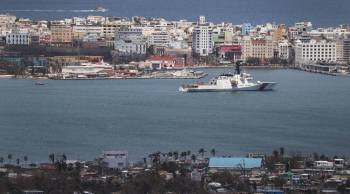UPDATED: Superstorm Sandy: Doing the numbers
People in the Northeast and Mid-Atlantic states woke up Tuesday morning to the devastating results of what is now called “Superstorm” Sandy.
Sandy made landfall on the New Jersey coast near Atlantic City and dropped from hurricane status, but winds were still peaking at 90 miles per hour.
The U.S. death toll from Sandy stood at 17 on Tuesday morning. The night brought a storm surge of 14 feet to Manhattan, inundating subways, tunnels and the 9/11 site with water from New York Harbor and the East River. A million people are under orders to evacuate across a dozen states.
At least eight million people were without power Tuesday morning. The storm, extending as far as 900 miles, has affected roughly 20 percent of the U.S. population. Power outages were most extensive in the Mid-Atlantic states — Delaware, New Jersey, New York, and Pennsylvania — but reached from Maine to the Carolinas, and inland to West Virginia, Ohio, and Indiana.
Exelon’s Oyster Creek nuclear power plant on the New Jersey coast — which is the oldest in the U.S. — issued an alert because of rising waters. Federal inspectors have been dispatched to monitor that plant and eight others in the path of the storm. A ConEd power substation suffered an explosion in lower Manhattan — the cause was unknown. Power was also out at NYU’s hospital in Manhattan after backup generators failed.
The economic cost of Sandy could ultimately place it in the top-10 most expensive hurricanes in U.S. history. A preliminary estimate from the forecasting firm EQECAT predicts the total economic cost at $10 to $20 billion. Of that, approximately half will be covered by insurance—for damage to homes, cars, and businesses.
Flood damage to homes and businesses is generally not covered by insurance policies. Much of the cost for clean-up and rebuilding from flooding will be provided by the federal National Flood Insurance Program. Insurance experts say so far this year, the industry has suffered lower-than-average payouts, and insurers have ample resources to cover Sandy’s costs.
To put Sandy in context: Hurricane Katrina in 2005 was the country’s most expensive hurricane, with nearly $50 billion insured losses. Hurricane Andrew in 1992 cost $23 billion. Hurricane Ike in 2008, and Hurricane Wilma in 2005, each had under $15 billion in insured losses. Hurricane Sandy will likely cost about double what Hurricane Irene did in 2011.
“In terms of the insured losses — it’s somewhere in the $5-10 billion range, and the overall economic losses perhaps being double that amount,” says Robert Hartwig, president and economist for the Insurance Information Institute. Hartwig says information on losses is still coming in: “Obviously it’s just now becoming light on the Eastern seaboard and there are several major unanswered questions — the extent of the storm surge along the New Jersey Shore, and then another big wild card is the power outages in major parts of the New York metro area including lower Manhattan.” Another big unknown, according to Hartwig, is how long it will take businesses to begin operating again, which will determine revenue losses resulting from the storm.
Tuesday the New York Stock Exchange will again be closed for both floor and electronic trading. It’s the first time in more than a century that the market has been closed for two days due to weather. NYSE ARCA — the exchange’s electronic trading system—will do a test Tuesday in the hope of opening trading on Wednesday, even if the stock exchange’s trading floor on Wall Street cannot open.
Market officials said after the storm that famous trading floor itself is undamaged from extensive flooding in lower Manhattan. Investors are eager to be able to trade on Wednesday, the last day of October, since it is the date for traders and fund managers to adjust their portfolios.
John Canally is chief economist at LPL Financial. “The markets were closed after 9/11, and all the trades just catch up all at once. Once trading resumes, prices will adjust to where they should be. But that first couple days or so could be pretty volatile.”
The last time the market closed for this long due to weather was in 1888, when a huge late-winter blizzard dumped 21 inches of snow on Manhattan in mid-March, and shut down Wall Street for two days.
There’s a lot happening in the world. Through it all, Marketplace is here for you.
You rely on Marketplace to break down the world’s events and tell you how it affects you in a fact-based, approachable way. We rely on your financial support to keep making that possible.
Your donation today powers the independent journalism that you rely on. For just $5/month, you can help sustain Marketplace so we can keep reporting on the things that matter to you.


















